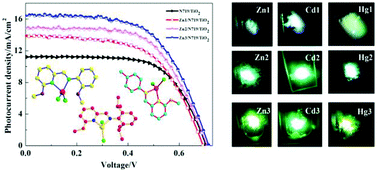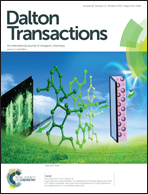Synthesis and characterization of substituted Schiff-base ligands and their d10 metal complexes: structure-induced luminescence tuning behaviors and applications in co-sensitized solar cells†
Abstract
Nine IIB group complexes, [ZnL1Cl2] (Zn1), [CdL1Cl2]2 (Cd1), [HgL1Cl2] (Hg1), [ZnL2Cl2] (Zn2), [CdL2Cl2] (Cd2), [HgL2Cl2] (Hg2), [ZnL3Cl2] (Zn3), [CdL3Cl2] (Cd3) and [HgL3Cl2] (Hg3), have been synthesized from the corresponding ortho-(6-methoxy-pyridyl)(CH![[double bond, length as m-dash]](https://www.rsc.org/images/entities/char_e001.gif) NAr) (where Ar = 2,6–iPr2C6H3, L1; 4–MeC6H4, L2; 2–OMeC6H4, L3) Schiff base and structurally characterized by elemental analysis, FT-IR, 1H NMR and X-ray single-crystal analysis. Crystallographic studies reveal that the center metal of the complexes adopts a distorted tetrahedron geometry (except for Cd1 and Cd3, which display square pyramidal geometry) and C–H⋯Cl hydrogen bonds and π⋯π stacking interactions contribute to three-dimensional supramolecular structures. The series of complexes exhibit tunable luminescence from blue, through green, to light yellow by varying the temperature (298 K and 77 K), both in solution and in the solid state. Moreover, the quantum yields range from 0.027 to 0.422, and decrease according to the order of the periodic table (Zn > Cd > Hg). These results indicate that the center atom of the complexes leads to the geometry differences and hence to the tunable luminescence properties. Because Zn1–Zn3 exhibited higher molar extinction coefficients and a distinct absorption region, they were employed as co-sensitizers in ruthenium dye N719-sensitized photoanodes to deliver light-electricity efficiency enhancement, being assembled with counter-electrodes and electrolyte to prepare ZnX/N719 (where ZnX = Zn1, Zn2 and Zn3) co-sensitized dye sensitized solar cell (DSSC) devices. The prepared co-absorbent could overcome the deficiency of N719 absorption in the low-wavelength region of the visible spectrum, and offset competitive visible-light absorption of I3−. Application of these prepared complexes in N719-sensitized solar cells enhanced their performance by 10–36%, which indicated a potential application of these types of complexes in DSSCs.
NAr) (where Ar = 2,6–iPr2C6H3, L1; 4–MeC6H4, L2; 2–OMeC6H4, L3) Schiff base and structurally characterized by elemental analysis, FT-IR, 1H NMR and X-ray single-crystal analysis. Crystallographic studies reveal that the center metal of the complexes adopts a distorted tetrahedron geometry (except for Cd1 and Cd3, which display square pyramidal geometry) and C–H⋯Cl hydrogen bonds and π⋯π stacking interactions contribute to three-dimensional supramolecular structures. The series of complexes exhibit tunable luminescence from blue, through green, to light yellow by varying the temperature (298 K and 77 K), both in solution and in the solid state. Moreover, the quantum yields range from 0.027 to 0.422, and decrease according to the order of the periodic table (Zn > Cd > Hg). These results indicate that the center atom of the complexes leads to the geometry differences and hence to the tunable luminescence properties. Because Zn1–Zn3 exhibited higher molar extinction coefficients and a distinct absorption region, they were employed as co-sensitizers in ruthenium dye N719-sensitized photoanodes to deliver light-electricity efficiency enhancement, being assembled with counter-electrodes and electrolyte to prepare ZnX/N719 (where ZnX = Zn1, Zn2 and Zn3) co-sensitized dye sensitized solar cell (DSSC) devices. The prepared co-absorbent could overcome the deficiency of N719 absorption in the low-wavelength region of the visible spectrum, and offset competitive visible-light absorption of I3−. Application of these prepared complexes in N719-sensitized solar cells enhanced their performance by 10–36%, which indicated a potential application of these types of complexes in DSSCs.


 Please wait while we load your content...
Please wait while we load your content...